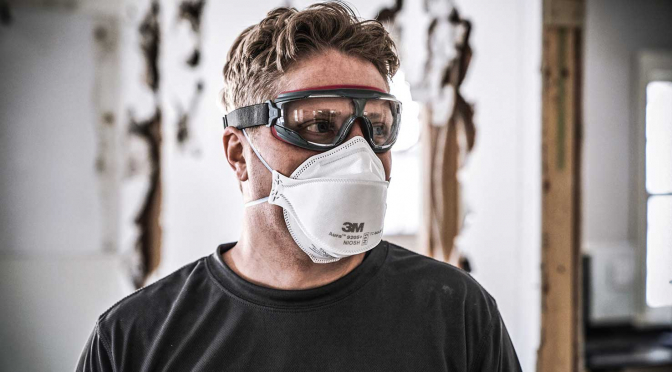Disposable respirators are a good way to protect you and crew on the job site. In this article, the product experts at 3M answer common contractor questions about using respirators when you have a beard or other facial hair.
Can I wear a disposable respirator if I have a beard?
If you want the respirator to help provide its full protective benefits, the answer is ‘no.’ This is because the seal of the respirator to the face is critical. Disposable and reusable respirators are designed to create a tight seal to the wearer’s face so that air entering the facepiece is forced through the filter media, and leakage between the facepiece seal and the face is reduced. Anything that prevents the edge of the respirator from creating that seal with the skin on the face can reduce the protection afforded by the respirator. Even short stubble under the edge of the respirator can compromise the seal. A short mustache or goatee could be acceptable, however it must fit completely inside the respirator and not cross the sealing surface. NIOSH released a facial hair chart endorsed by the CDC that helps explain the types of acceptable facial hair options. Please check it out. Also, please also be sure to read and follow the respirator User Instructions.
The need for proper fit testing and education
Any painting professional required to wear a respirator must be fit tested at least once a year, usually by an appointed company safety lead or an industrial hygienist. It should be emphasized that the safety lead should also train the employees on a variety of aspects regarding their respirator, such as how to wear it correctly, how to inspect it for damage, how to maintain the product, why they need to go through a fit test each year, and of course, why they need to be clean shaven. This can help employees better understand both the importance of using the equipment properly, and the safety value in a close shave as well.
Let’s discuss some of these, starting with fit testing. What is a fit test and what is it “testing” for? A fit test is a relatively short test, using specific protocols, to show that an individual can achieve an effective seal with a particular disposable or reusable respirator. To perform a fit test, the user must go through various acts like nodding your head up and down, breathing in and out heavily, and bending over. These motions are meant to mimic real-life situations on the job where you need the seal to stay in place. This is why a clean-shaven face is so critical. In fact, according to NIOSH, some studies have shown that even a five o’clock shadow can interfere with the seal and reduce protection.
Another critical aspect of helping achieve a good seal is the position of the respirator and straps on the face and head, which is why a user needs to be educated on proper fitting instructions. For example, for disposable respirator head straps, the top strap must go over the crown of your head, above the ears, and the bottom strap must go below the ears and around the neck. They shouldn’t be crisscrossed, nor both above or both below the ears. This proper placement can help the edge of the respirator form a good seal to your shaved face. Of course, the user should always read the full User Instructions for their specific respirator.
Properly forming the noseclip to your nose is another key tip. Do not pinch the nose piece with one hand because it could crease the noseclip and cause leakage around the nose. You should take your time to gently form the nose piece slowly using both hands, like you’re molding clay around the nose. That will help provide you a more secure seal.
New respirator styles offer more options
3M has recently expanded production of the Aura™ Particulate Respirator 9205+, a horizontal N95 flat-fold model. The Aura’s tri-fold, three-panel design lays flat prior to use, making it more convenient to store without the concern of crushing it, which might occur with the traditional cup-style N95 respirators. The three-panel design flexes with the mouth and helps accommodate facial movements, and has also shown the ability to fit a wide range of faces shapes and sizes. This flat-fold respirator provides another option for people to try when seeking to achieve a good fit with their respirator.
We understand that facial hair is an expression of personal taste, style, and even values to some. But when you make the decision to be clean-shaven (or to choose a facial hair style that can accommodate an adequate seal for your respirator), you also make the choice to help ensure you achieve the protection your respirator was designed to offer you.
To learn more about proper fit, choosing the right respirator and other respirator topics, visit the 3M Center for Respiratory Protection.

